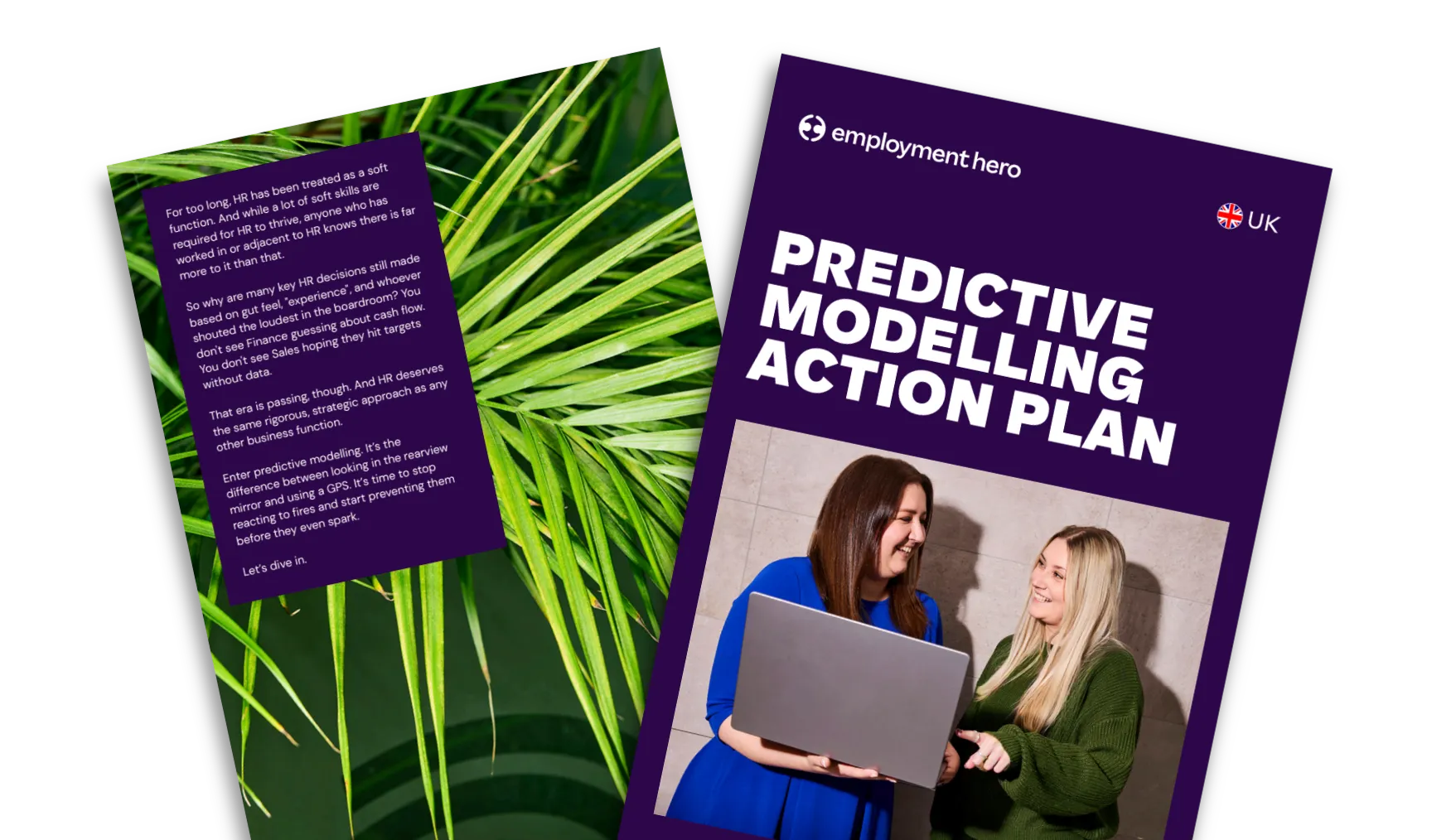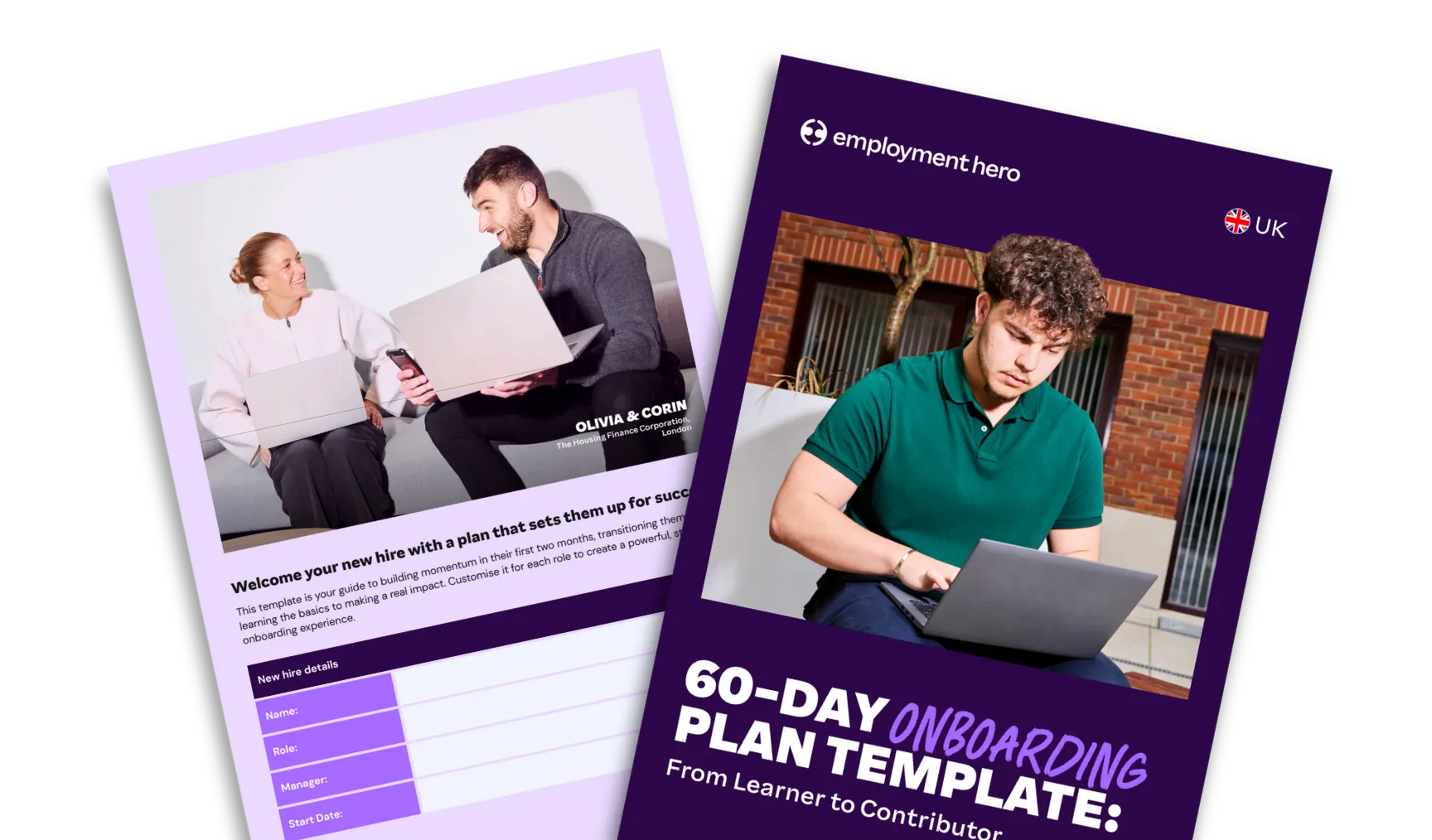How to create a standout employee experience (EX) in 7 steps
Published
How to create a standout employee experience (EX) in 7 steps
Employee experience (or EX) has quickly become one of the most important drivers of workplace success. Companies that get EX right typically see higher engagement, lower turnover and a stronger employer brand.
44% of UK workers listed a positive employee experience as a top priority in the quest for better engagement and retention.
In this guide, we’ll walk you through what an employee experience strategy actually is, why it matters and the seven practical steps you can take to design one that will keep your people happy and productive.
What’s in the employee experience guide?
From the hiring process right through to exit interviews, designing your employee experience can make a huge difference when it comes to keeping your team happy, engaged and loyal.
In this guide, we’ll show you how to create a standout employee experience that will turn your team into brand advocates. Inside, you can get insights into:
- What is the employee experience (EX)?
- Using the employee lifecycle to create a standout experience
- Using EX to recruit and attract talent
- Breaking down your EVP and employer brand
- How to improve the candidate experience
- Leveraging EX for onboarding
- Implementing professional development plans
- How EX impacts retention
- Using reward and recognition programmes for EX
- Maintaining EX during offboarding
Considering we spend on average one-third of our lives at work, you want to make your employees feel valued and positive about logging on for the day. Download the guide now.

What is an employee experience strategy?
At its core, an employee experience strategy is the deliberate design of every interaction an employee has with your company, from the moment they spot your job ad to the day they leave (and even beyond, if you want them championing your brand).
It goes further than a general HR strategy. While HR traditionally focuses on policies and processes, EX is about the holistic journey. These include:
- Recruitment: how candidates are treated before they join
- Onboarding: how welcome and supported they feel from day one
- Development: the opportunities you provide to grow and thrive
- Retention: how you recognise and reward their contributions
- Exit: how you part ways and maintain relationships after they leave
A good EX strategy considers all of these stages, tying them back to your company’s mission and culture and making sure employees feel valued throughout.
Why employee experience matters more than ever
The pandemic fundamentally shifted what employees expect from work. Remote and hybrid arrangements are no longer emergency measures but desired work benefits. The Great Resignation might have calmed down, but the underlying sentiment remains: people want work that feels meaningful, manageable and aligned with their values.
From a business perspective, the numbers tell a compelling story. Gallup showed that companies with highly engaged workforces show 21% greater profitability and 10% higher customer ratings than their competitors. When you factor in the average cost of replacing an employee (ranging from 50% to 200% of their annual salary), investing in employee experience quickly becomes both a moral and financial incentive.
Beyond the hard metrics, there’s your business’s reputation. In an age where employer reviews are just a Google search away, your employee experience directly impacts your ability to attract top talent. A strong EX strategy turns your workforce into your best recruitment tool.

The business case for investing in employee experience
Building a compelling business case for EX investment requires connecting employee satisfaction to business outcomes. Here’s how to frame the argument:
Revenue impact
Engaged employees drive higher revenue, and that’s higher revenue per happy employee. They’re more innovative, take fewer sick days and deliver better customer service. When employees feel valued and supported, that energy translates directly to customer interactions and business results.
Cost reduction
High turnover is expensive. Beyond recruitment and training costs, there’s the hidden expense of lost productivity, knowledge drain and the impact on remaining team members. A strong EX strategy can reduce turnover, offering cost savings.
Talent attraction
In competitive job markets, EX becomes your differentiator. Companies known for great employee experiences can attract candidates faster and often at lower salary costs because the total package is more appealing.
Innovation catalyst
Employees who feel psychologically safe and valued are more likely to share ideas, take calculated risks and contribute to innovation. This creative energy often leads to breakthrough products, process improvements and competitive advantages.

Seven steps to build an effective employee experience strategy
Building a great employee experience doesn’t have to be overwhelming. In the steps ahead, we’ll show you how to map the employee journey, gather feedback that matters, define a clear vision and bring your values to life. From onboarding to recognition, development to offboarding, you’ll see how straightforward actions can transform how your team feels about work.
1. Map the full employee journey
From pre-hire interactions to offboarding, every stage deserves attention. Start by mapping the key touchpoints across the employee lifecycle. The journey begins the moment someone encounters your employer brand, whether on job boards, social media or through word of mouth. The application process, interview experience and offer communication all set expectations before day one.
For onboarding, every detail should reflect your values and set the tone for the journey ahead, from workspace setup and introductions to early projects and feedback sessions.
The ongoing employment phase is where most experience happens. Daily work, career development, recognition and how challenges are handled all compound over time, with small improvements creating a big cumulative impact.
Finally, the exit process matters more than many realise. How you manage departures shapes not only the leaver’s perception but also how the rest of the workforce views your culture.
2. Gather feedback that matters
Employee sentiment shifts quickly, so you need multiple feedback channels across the journey. Pulse surveys should be short, frequent, and focused on specific aspects of the experience. Monthly or quarterly pulses can track sentiment trends and spot issues early, provided the right questions are asked and responses acted on promptly.
Stay interviews are another essential tool. Unlike exit interviews, which come too late, stay interviews focus on why employees stay, what engages them and what might make them leave. Run these regularly with top talent, keeping conversations honest and focused on their experience.
Real-time feedback channels such as suggestion boxes, anonymous chat or team retrospectives encourage continuous input. The goal is to make feedback a natural, ongoing part of work rather than an annual ritual.
3. Define your EX vision and values
Your EX strategy should mirror your wider mission but be specific enough to guide daily decisions. If innovation is central to your brand, employees should experience room to experiment, learn and even fail safely.
Define the kind of workplace you want to create. Your vision should answer questions like:
- How do we want employees to feel about their work?
- What behaviours do we want to encourage?
- How should we be known as an employer?
Translate EX values into observable actions. If “growth” is a core value, it should show up in career development, learning budgets, stretch projects and how managers treat mistakes. If “inclusion” is a value, it must be visible in recruitment, team dynamics, communication and leadership representation.
Our guide dives much deeper into all these stages of the EX journey, so be sure to download it for the full breakdown.
4. Design for inclusion and personalisation
Modern workforces are diverse in age, background, working style, career stage and personal preference. EX strategies should build flexibility within structure.
Generational needs differ. Early-career employees may seek rapid progression, mid-career staff might prioritise balance and senior employees often value meaningful work and mentoring. Role-based needs also vary.
Sales teams might thrive on competitive recognition, while creative teams may prefer collaborative feedback. Remote and office-based employees will need different approaches to connection.
In the UK, hybrid work is now standard, so flexibility must be built in. Focus on outcomes, ensure equal opportunities regardless of location and create deliberate opportunities for collaboration. Cultural inclusion also matters. Employees from different backgrounds may prefer different communication styles, celebrations, and working approaches. Designing experiences that respect these differences strengthens belonging.
5. Enable with the right tools and tech
Technology should simplify work. Start by auditing your tech stack and removing tools that create friction.
Likewise, communication platforms should connect your people, not overwhelm them. Whether you use Teams, Slack or another tool, clarity about when and how to use each channel prevents important information from being lost. Performance tools should support continuous check-ins, goals and feedback rather than relying only on annual reviews.
Recognition platforms can boost engagement when they tie recognition to company values and deliver rewards to employees’ value. Learning platforms should create personalised development paths blending training, mentoring and on-the-job learning.
6. Train managers as experience champions
Managers shape culture more than any HR policy. They are the daily link between organisational intent and employee reality, so investing in them is critical.
Start by promoting managers for leadership ability, not just technical skill. Emotional intelligence, coaching skills and a commitment to development should be part of selection criteria.
Provide ongoing training across both hard and soft skills. This should cover one-to-ones, feedback, performance conversations, empathy and psychological safety. Give managers toolkits with conversation guides, career frameworks and recognition resources so they can deliver consistent experiences.
7. Measure, adjust, repeat
You wouldn’t run payroll without checking the numbers, and EX is no different. Measuring requires both quantitative and qualitative insights.
Quantitative metrics include eNPS, turnover and retention rates, engagement scores and internal mobility rates. Always break data down by department, demographics and tenure to uncover trends and hotspots.
Qualitative insights from exit interviews and stay interviews can add context to the numbers and reveal root causes. Most importantly, act on what you learn. Close the loop by showing employees how feedback has shaped change.

Common EX strategy mistakes and how to avoid them
Ready to start on your EX strategy? We’ve compiled a list of common mistakes that employers make when building the plan and how you can avoid them.
Treating perks as culture substitutes
Perks like pizza Fridays or ping pong may spark initial excitement, but they don’t replace meaningful culture.
Engagement comes from clear communication, fair treatment, growth opportunities, recognition and manageable workloads. Use perks to reinforce culture, not create it.
Ignoring feedback until exit interviews
Exit interviews are useful, but they come too late to retain talent. Instead, run stay interviews with top performers, pulse surveys and onboarding check-ins to capture feedback earlier.
Make sure to act on that feedback where possible. Employees are more likely to keep sharing if they see tangible change or understand why certain suggestions weren’t adopted.
One-size-fits-all implementation
Rolling out identical initiatives across all roles or demographics rarely works. Segment employees by role type, career stage or working arrangement, and pilot new initiatives before scaling.
Offer choice where possible. Recognition, learning formats and benefit packages can be tailored while still achieving the same outcomes.
Focusing only on engagement scores
Engagement scores matter, but optimising for the number alone risks superficial change. Balance survey results with business outcomes such as productivity, customer satisfaction and innovation.
Dig deeper into engagement data to uncover pockets of disengagement or drivers of success.
Measuring ROI and building the business case
Linking EX to financial impact secures leadership support. While some benefits are intangible, many can be quantified.
Calculate cost savings from reduced turnover by factoring in recruitment, onboarding, training and productivity loss. Measure productivity improvements through revenue per employee, customer satisfaction or project completion rates.
You can also track customer impact, as engaged employees often drive retention and sales.

Tools, templates and resources to get started
If you’re looking for more templates and tools to help with your EX journey, Employment Hero has created resources to help you get started:
- Employee Retention Strategy Guide: Learn practical strategies to keep your top talent, reduce turnover and build a loyal, motivated workforce.
- Employee Engagement Guide: Discover how to drive engagement through recognition, meaningful work and feedback, creating a culture where employees thrive.
- Reduce Staff Turnover Guide: Explore actionable steps to identify retention risks, improve job satisfaction and maintain continuity across your teams.
- Employee Experience Software: Employment Hero’s EX software boosts employee engagement with rewards, recognition and performance tools. It helps employees manage work admin like timesheets and leave, while supporting career growth.
Get started on your Employee Experience strategy today
EX will continue to evolve with technology, shifting expectations and global events.
AI will personalise learning and career paths, but human leadership remains vital for trust and empathy. Skills-based career development will overtake traditional ladders, while purpose-driven work will grow in importance. Flexibility will expand beyond location to schedules, career paths and benefits.
The most successful EX strategies will balance personalisation with business goals, ensuring employees feel supported while the organisation thrives. Looking to create a better employee experience for your team? Download the guide now.
Register for the Downloadable
Related Resources
-
 Read more: Predictive Modelling in HR: Stop Guessing, Start Winning
Read more: Predictive Modelling in HR: Stop Guessing, Start WinningPredictive Modelling in HR: Stop Guessing, Start Winning
Discover how predictive modelling in HR can transform decision-making. Learn about key models, algorithms and steps to implement predictive analytics.
-
 Read more: Team Cohesion: The Ultimate Toolkit For Cross-Functional Collaboration
Read more: Team Cohesion: The Ultimate Toolkit For Cross-Functional CollaborationTeam Cohesion: The Ultimate Toolkit For Cross-Functional Collaboration
Learn how to build team cohesion and improve cross-functional collaboration. Discover actionable strategies, team-building activities and key behaviours.
-
 Read more: Your 60 day onboarding plan: The free template for building momentum
Read more: Your 60 day onboarding plan: The free template for building momentumYour 60 day onboarding plan: The free template for building momentum
Download a free 60 day onboarding plan template. Learn how to set clear goals, track progress and ensure new hire…



















